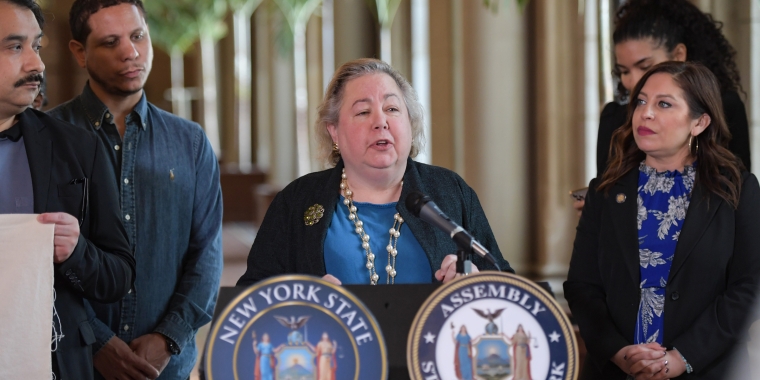
Testimony Before the Department of Sanitation Regarding the Draft Scoping Document for the Environmental Impact Statement for the Comprehensive Solid Waste Management Plan on June 28th, 2004
Liz Krueger
July 12, 2010
Good evening. My name is Liz Krueger and I am the State Senator for New York’s twenty-sixth senatorial district, one primarily comprising parts of Manhattan’s Midtown and East Side. I would like to thank the Department of Sanitation (DSNY) for hosting this public hearing and allowing me to speak.
I was alarmed when initially notified of the DSNY’s intention to resume operation at the 91st-Street marine transfer station (MTS). Although this MTS was an active component in the City’s waste disposal system as recently as 1999, its location both within a serene residential neighborhood and adjacent to a resource like Asphalt Green—a City park and needed recreation space for the Upper East Side and all of the City—would hopefully dissuade a restoration of service given the intrusions beyond adequate mitigation promised by a facility that will undoubtedly emit pungent odors, host a constant procession of pollutant-emitting trucks, and create maddening traffic disarray. In other words, the proposed site is completely inappropriate and unacceptable.
That said, I remain convinced that marine transfer stations can play an important role in solving New York City’s waste management problems. Furthermore, I recognize that waste disposal is a messy issue because garbage, by definition, is not anything that anyone wants any part of. Accordingly, I am sympathetic to the demands placed on the DSNY. The “not-in-my-backyard” syndrome (NIMBY) is one that has routinely complicated waste disposal planning. So that I am not seen as a NIMBYist, I would like to make clear that I do not oppose the placement of a marine transfer station on the East Side. We must all be responsible for our own waste, and I encourage DSNY to find a suitable MTS site within the boards that this one would serve. However, the proposed site at 91st Street—behind Asphalt Green and just north of Carl Schurz Park and several landmarks—is completely inappropriate because it would fundamentally alter the character of a dense, residential neighborhood and irrevocably harm Asphalt Green, a unique resource.
Criticism without suggestion is easy to offer, though, and lest anyone mistake this testimony as anything other than constructive, I would like to assist the Sanitation Department’s good-faith efforts to produce an environmental impact statement (EIS) by offering several concerns that should each receive genuine, close consideration. The Department, if it acts responsibly, will find the 91st-Street site wholly unfit to host the converted MTS currently proposed.
The draft scoping document sets inadequate and incomplete parameters for a legitimate environmental impact study, severely neglecting the maximum operation capacity of the converted MTS at 91st Street and, resultantly, woefully underestimating the mitigation required to compensate for the tremendous burdens that would be subsequently created. As written, the scoping document will yield an EIS that does not properly account for the traffic, odor, noise, air quality, and health impacts that the MTS at 91st Street would create. Additionally, it erroneously excludes consideration of landmarks like Gracie Mansion, the Church of the Holy Trinity, the Municipal Asphalt Plant that now houses Asphalt Green, and Henderson Place within a half-mile radius of the proposed MTS site; a cost-benefit analysis of the retrofitted MTS site compared to the five token alternatives explored; and alternative sites for the proposed MTS. I sincerely hope that the DSNY closely listens to the plethora of logical objections that will be presented by many speakers tonight and faithfully administers a review process that yields a comprehensive and responsive environmental impact statement.
Despite being unclear about the design of the new facility and the mitigation options for its myriad negative impacts, the SWMP makes clear that the marine transfer station at 91st Street will be expanded and improved, replete with a bigger footprint, a larger building, and a greater capacity for waste. The plan forecasts that 91st Street will receive roughly 1,190 tons of residential garbage per day, however it also discloses that the MTS could accommodate up to 4,290 tons of refuse in that same twenty-four hours if so required. The 4,290-ton capacity mentioned in this draft scoping document seems to account for the commercial waste that could be delivered to the 91st-Street station were the City to also implement its commercial waste plan, a schematic already studied by the DSNY. To conclude that the proposed MTS at 91st Street would become a destination for commercial trash seems rational and justified because the plan has already been considered, the garbage will not dispose of itself, and New York City must immediately begin to correct its deficient waste management system. So what would that mean for the Upper East Side?
An MTS receiving 4,290 tons of trash from four community boards would operate six days a week and receive trucks throughout the day and night. As these trucks traveled to their destination, they would increase the volume of traffic on already-crowded streets, sit in a queue along York Avenue, and carry a trail of odor that would significantly alter the character of the neighborhoods through which they passed. The stench would be particularly strong around Carl Schurz Park and Asphalt Green, two open spaces that serve an Upper East Side generally bereft of true parkland. While the City should be commended for converting its fleet of garbage trucks to one populated by vehicles whose engines burn biodiesel fuel, these vehicles do still release some unhealthy emissions, and many of the merchant carriers who would also deliver refuse to the MTS at 91st-Street continue to rely on heavy-polluting diesel trucks responsible for sulfur-, nitrogen, and carbon-based emissions.
This bleak, though thankfully still hypothetical, circumstance will become a reality if the marine transfer station behind Asphalt Green is converted and reopened. New York City would be committing an injustice against its own citizens. To ameliorate any confusion about this outcome, the Department of Sanitation must conduct a thorough environmental impact study including the worst-case, 4,290-ton scenario “…Consideration will be given to possible traffic, air and noise impacts attributable to the facilities and their possible impacts upon nearby open spaces, if applicable,” is what the scoping document says about open-space impacts. A circumstance in which large, polluting trucks filled with refuse rumble through Asphalt Green at all hours qualifies.
The draft scoping document is serially plagued by this sort of myopic planning. The proposed traffic analysis, for instance, will be one conducted under the assumption that the 91st-Street MTS will receive 1,190 tons of garbage each day. However, as earlier discussed, there is a great likelihood that the MTS will instead receive 4,290 tons. As a result, the current traffic projections are dangerously obsolete! On peak collection days, the MTS would receive 469 delivery vehicles, not 130. On off-peak days, the site would still need to accommodate—given a conservative assumption of 15-percent less traffic—398 trucks, or seventeen per hour. While the scoping document is vague or neglectful concerning the MTS design and the refuse offloading process, it seems fair to assume that in order to go through Asphalt Green, unload its contents into non-spill containers, turn around, and then exit, each truck will require more than the three-and-one-half-minutes average that the current plan would allow. Reconfiguring a few intersections or altering some traffic light patterns seem like hopeless remedies for this potential plague.
As trucks took longer to unload their cargo, those that arrived later would begin to line-up along the delivery routes—the narrow streets running east-west and congested York Avenue, a thoroughfare that already barely accommodates two bus routes, FDR Drive access, and a high volume of cars. While idling, waiting to dispatch the waste that they carried, the trucks would be sitting with their motors running, releasing exhaust pollutants, emitting odors, and creating a din. Again, I must return to the faulty parameters proposed by this document when I assert that this situation will cause problems for which there is no adequate mitigation.
Here’s an example: Under the residential-waste only assumptions, the scoping document concludes that the odor impact of the trucks will be one that is detectable though not insufferable. Any already detectable foul scent would likely be unbearable were its intensity increased four-fold, as would be the case given the staggering number of additional trucks that would enter the area. Such an impact cannot be mitigated, and it would effectively ruin the crucial facilities in the area, like Asphalt Green. Similar arguments can be made about the four-fold increase in traffic, noise, and air pollution. If you think that driving on York Avenue is already frustrating, wait until there are standing trucks constantly clogging the road; if you currently enjoy a restful evening of sleep, remember it fondly as diesel engines roar throughout the night. A single area of Manhattan should not be asked to accommodate these overwhelming impacts.
Beyond the environmental and quality-of-life problems that the MTS would cause at this location, there would also exist a significant threat to public health. With fifty-five schools sending almost 4,000 children to Asphalt Green for recreational activities, permitting heavy polluters like diesel-fuel trucks to constantly idle near the site and imperil a population particularly susceptible to respiratory ailments is not only unsafe but negligent. New York City already has alarmingly high rates of asthma among some youth populations, and the proposed MTS at this location could push those frightening numbers higher.
The effects of converting the MTS in question will be disastrous: a renovated station would stagnate traffic flow, destroy air quality, erode the character of a neighborhood, threaten the safety of our children, create noise pollution, emit unbearable fumes, and cripple Asphalt Green.
An appropriate EIS—one that displays a far greater understanding of these ramifications than the scoping document that preceded it—would account for residential and commercial waste processing at the 91st-Street MTS, strenuously explore other sites along the East Side that could host a marine transfer station, and fairly assess the risks associated with the proposed location. If the EIS accomplishes all this, I feel confident that Asphalt Green and the residents of Gracie Point will have nothing to fear. There is a place for a marine transfer station on the East Side, just not at 91st Street. Thank you for your time.
Share this Article or Press Release
Newsroom
Go to NewsroomSenator Krueger's May 2024 Update
May 30, 2024



